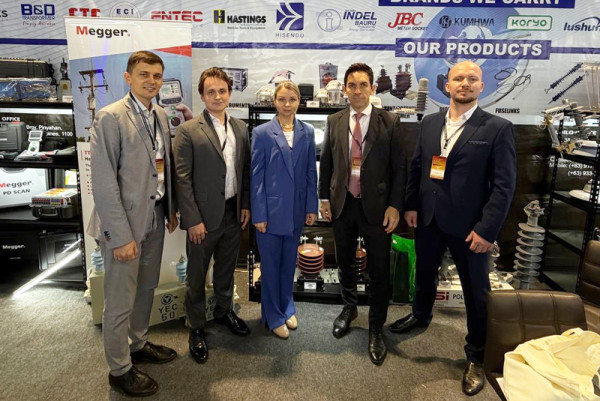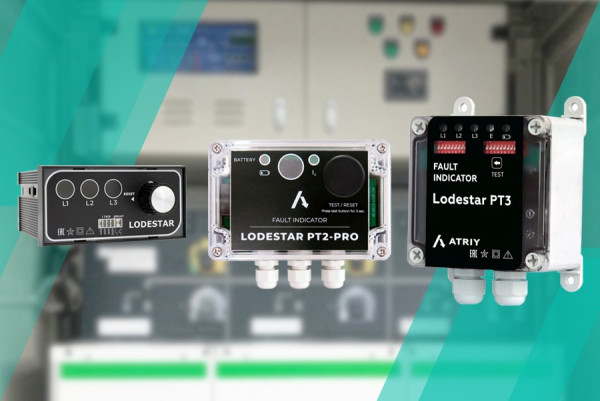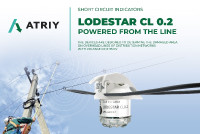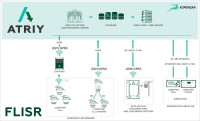ATRIY in the Philippines: Powering Reliability in the Tropics
ATRIY LLC рparticipates in the 50th Annual National Convention (ANC) and the 3E XPO 2025, held at in Philippines. Hosted by the Institute of Integrated Electrical Engineers of the Philippines, Inc. (IIEE), this landmark "Golden Year" event is the premier gathering for professionals in the electrical, electronics, and energy engineering sectors.
At the exhibition, ATRIY's innovative devices are being featured at the booth of our partner company, CENTRADE. For more than five years, they have been purchasing our equipment for the Philippine power grid, as they believe that our devices can reliably operate in high humidity and strong winds, helping power grid operators identify damaged sections of the grid in real-time.
Our specialists are on site demonstrating the company's flagship products: the Lodestar CL0.5B and Lodestar CL0.5 BM series Fault Passage Indicators. These top-of-the-range solutions are designed for the rapid detection of fault location and direction on overhead power lines.
The significant interest and positive reception from exhibition visitors towards our products are a tremendous reward for our team. Such feedback strengthens our commitment to the strategic goal: ensuring the highest level of power supply reliability worldwide.
Understanding ground fault indicators - how ground fault monitoring works
In any modern industrial or commercial facility, the safety and reliability of the electrical network are paramount. An unexpected interruption in the power supply can halt production, while an undetected electrical fault can lead to catastrophic equipment damage, fires, and severe safety hazards. One of the most common and dangerous types of faults is a ground fault. To combat this risk, specialized safety devices known as ground fault indicators are essential. These devices serve as the first line of defense, providing early warnings of potentially hazardous conditions long before they escalate, ensuring the entire installation remains stable, safe, and productive.
How Ground Fault Indicators Detect Faults
The fundamental principle behind ground fault indicators is the constant monitoring of current balance within an electrical circuit. In a properly functioning, healthy grounded system, the current flowing from the source to the load through the phase conductors is exactly equal to the current returning. There should be zero current leakage to the ground. However, when a ground fault occurs—often due to deteriorating insulation, moisture, or accidental contact—a portion of the current escapes its intended path and flows directly to the ground. This creates a dangerous imbalance in the circuit.
This is precisely what ground fault indicators are designed to detect. Using highly sensitive current sensors, known as Core Balance Current Transformers (CBCT) or toroidal transformers, which enclose the phase and neutral conductors, the device continuously measures the vector sum of the currents. When this imbalance exceeds a predetermined, safe threshold, the indicator immediately triggers an alarm. For personnel safety, this threshold is often as low as 5-30 mA. For equipment protection, where the goal is to prevent damage from sustained, low-level arcing faults, the sensitivity might be set higher (e.g., 100-500 mA). This alarm is typically a visual signal, like a flashing red light, or an output relay that can be connected to a larger control system, alerting personnel that a specific part of the electrical infrastructure requires immediate attention. These advanced products are critical for maintaining the health of any power system.
Types of Ground Fault Indicators and Their Applications
Not all solutions are created equal. The right choice depends on whether the priority is protecting people, protecting equipment, ensuring continuity, or locating the fault.
Type AC / Type A (RCD/GFCI — high sensitivity for people):
Used for personnel safety on relevant low-voltage circuits. They disconnect rapidly at low residual currents (see values above) to mitigate the risk of electric shock in workshops, laboratories, and areas with frequent human–equipment interaction.
Adjustable, time-delayed protection for selectivity (Type S RCD / GFPE):
In complex industrial settings, continuity of service and selective tripping are critical. Time-delayed/selective devices let engineers coordinate sensitivity and intentional delay (typically tens to hundreds of milliseconds for selective RCDs; higher-amp settings for GFPE on services/feeders) so harmless transients (e.g., motor inrush) don’t cause upstream trips, while sustained faults are cleared in the correct location.
Panel-mounted monitors (RCM):
Residual current monitors display or transmit real-time leakage values. Trending a slowly increasing residual on a critical motor is a classic early sign of insulation degradation—ideal for predictive maintenance. RCMs provide signaling but do not perform automatic disconnection.
RCMs provide signaling but do not perform automatic disconnection.
Fault Passage Indicators (FPI/FCI) for feeders (MV):
When the task is to find where the fault occurred on medium-voltage feeders, use ground fault indicators designed for MV networks—fault passage indicators. For example, the Lodestar PT2 helps quickly localize earth faults/short circuits along 6–35 kV overhead and cable lines, cutting patrol time and speeding restoration.
Key Benefits of a Robust Ground Fault Monitoring System
Integrating a network of appropriate ground fault indicators offers tangible returns through improved uptime and asset preservation. The primary advantages include:
- Enhanced Safety: By providing immediate alerts for hazardous ground faults, these indicators significantly reduce the risk of electric shock and fire. This offers superior safeguarding for personnel and the facility itself, which is always a high priority.
- Maximized Operational Uptime: In a continuous process environment, an unexpected shutdown is incredibly costly. Ground fault indicators allow a system to alarm without necessarily tripping, giving staff the chance to conduct an orderly shutdown or address the issue before a critical failure occurs, thus keeping the power flowing.
- Prevention of Costly Equipment Damage: An undetected, persistent ground fault can cause severe damage to motors and transformers. The early warning provided by ground fault indicators helps prevent this, avoiding expensive repairs and replacement costs.
- Simplified and Rapid Troubleshooting: When a fault occurs in a large industrial system, finding its location can be a time-consuming challenge. Consider a large manufacturing plant with dozens of machine lines. Without zoned monitoring, a ground fault could shut down the entire facility while electricians spend hours testing each circuit. With indicators on each feeder, an alarm instantly points to "Line 3, Stamping Press," reducing downtime from hours to minutes. This targeted approach is a cornerstone of an efficient maintenance system.
- Proactive Maintenance: A recurring fault alarm on a particular feeder can indicate deteriorating insulation or an aging piece of equipment, allowing maintenance to be scheduled proactively. This is vital in managing the lifecycle of high-voltage equipment. A low resistance path to ground during a fault is what can cause significant damage.
Debunking Common Myths
Misconceptions can lead to inadequate safety measures. Let's address some common myths about ground fault indicators.
- Myth 1: "They cause nuisance tripping." Reality: This is only true for incorrectly specified devices. Modern, adjustable products (like Type S relays) with configurable time delays can easily distinguish between a dangerous ground fault and a temporary inrush current from a motor, virtually eliminating false alarms.
- Myth 2: "A standard circuit breaker is enough." Reality: A standard breaker is designed to protect against overloads and short circuits (often hundreds of amps). It is completely blind to the low-level leakage currents (as low as 50 mA) that can be fatal to humans and cause fires. Relying solely on a breaker for ground fault protection is a dangerous oversight.
- Myth 3: "They are only for high-voltage systems." Reality: The risk of lethal electric shock is actually highest in common low-voltage (e.g., 230/400V) systems, where personnel are most likely to be working. Sensitive ground fault indicators are a necessity, not a luxury, in any electrical setup.
Ultimately, these advanced solutions are essential for any modern distribution network where safety and efficiency are top priorities, particularly in demanding grounded networks where the required level of resistance for proper operation must be maintained. A well-implemented setup is a hallmark of a reliable electrical installation.
Frequently Asked Questions (FAQ)
Q: What is the difference between a ground fault indicator and a ground fault relay?
A: While often used interchangeably, an "indicator" typically refers to a simple device that provides a visual alarm (a light). A "relay" is a more advanced device that includes an electrical contact (an output). This contact can be used to trigger an alarm, send a signal to a control system, or activate a shunt trip on a circuit breaker to de-energize the circuit automatically.
Q: Where are these devices typically installed?
A: They are installed at key points throughout a distribution network, such as on main switchgear, distribution panels, motor control centers, and individual feeder circuits. This allows a quick localization of a fault within the broader grounded network. These solutions are scalable for any setup.
Q: What is the difference between a ground fault and a short circuit?
A: A short circuit typically involves a very high current flowing directly between two or more phase conductors or between a phase and a neutral conductor. A ground fault, however, is the unintended flow of current from a conductor to the earth ground. Ground fault currents are often much lower than short circuit currents but can be equally, if not more, dangerous in terms of risk of fire and electric shock.
Q: What does a low insulation resistance value indicate?
A: A low resistance value for the protective covering in a circuit indicates that the material is degraded, damaged, or contaminated. This creates an easier path for current to leak to the ground, significantly increasing the risk of a fault. Monitoring resistance is a key part of ensuring the safety of a grounded system.
Innovative equipment for monitoring and controlling power lines in the GCC region
Autumn is a peak season for business activities, and the GCC region is not an exception. ATRIY's specialists presented their products at energy exhibitions in the United Arab Emirates and Saudi Arabia.
Wetex 2025, one of the key events in the energy industry organized by the Dubai Electricity and Water Authority (DEWA), was held in Dubai. There, we introduced representatives of energy companies to comprehensive solutions for the automation of energy facilities. We also presented the updated Lodestar PT2 PRO - short-circuit current indicator for cable lines, which was developed specially to meet DEWA's requirements.
Next, we visited the equally hospitable city of Riyadh for the Elenex 2025 exhibition. Our commercial and technical support teams held a series of successful meetings presenting equipment and software for monitoring distribution and high-voltage power lines, including indicators with high sensitivity to emergency currents from 0,2 А.
Today, ATRIY's equipment is already installed in major energy companies across the GCC and has proven its effectiveness in extreme conditions such as high temperatures, dust and sand.
We are committed to provide people around the world with reliable and uninterrupted energy supply!
Visit us at ELENEX 2025!
Dear partners,
We are exited to invite you to visit us at ELENEX 2025 in Riyadh, Saudi Arabia, October 6-8 at Riyadh International Convention Exhibition Center. Our specialists will present you our complex digital solutions for Energy leaders and our new products:
- equipment for monitoring and diagnostics of overhead lines, including Fault Passage Indicators powered from the line and sensitivity to emergency currents from 0.2 A;
- equipment for detecting cable line accidents, including the updated Earth Fault Indicator Lodestar PT2-PRO developed especially for DEWA;
- software solutions for overhead and cable line monitoring and control.
About the event:
Saudi Elenex 2025 is the leading gathering for the Lighting, Electricity, Alternative Energy, Air Conditioning and Water Technology sectors in Saudi Arabia.
Date: 6 - 8 October, 2025
Venue: Riyadh International Convention Exhibition Center
ATRIY LLC develops a wide range of technical solutions for the digital transformation of electric grids.
Our devices ensure monitoring and control of all nodes in the power lines, transformation and distribution substations.
ATRIY Company presents special models of fault indicators for overhead voltage lines.
Short circuit indicators Lodestar CL0.2B VEH are powered from the line.
The devices are designed to determine the damaged area on overhead lines of distribution networks with voltage of 6-35 kV.
Full information about the device is already available on the pages of our website.
Short circuit indicator Lodestar CL0.2B VEH
ATRIY Company presents special models of fault indicators for overhead voltage lines.
Short circuit indicators Lodestar CL0.2B VEH are powered from the line.
The devices are designed to determine the damaged area on overhead lines of distribution networks with voltage of 6-35 kV.
The Lodestar CL0.2B VEH does not have replaceable batteries, the indicator is powered directly from the line voltage (from 6 kV).
Advantages:
- Maintenance-free, no removable batteries and accumulators.
- Sensitivity to emergency process currents from 0.2A.
- Live line installation on any type of wire.
The Lodestar CL0.2B VEH set consists of three indicators and has a short-range radio channel for connection using the Lodestar App remote control. Lodestar CL0.2B VEH can communicate with different types of receiver models: Communication unit Lodestar Lightbox, Communication unit Lodestar Smartbox.
Communication units can transmit fault information to the KOMORSAN monitoring system or SCADA system via GSM/GPRS/3G (IEC60870-5-104, GRE, Ipsec, OpenVPN and other network protocols are possible).
Visit us at WETEX 2025!
Dear partners!
We would like to invite you to visit us on booth 1-C10 at WETEX 2025 Exhibition in Dubai, September 30 – October 02 where we will present our complex digital solutions for Energy industry and our new products:
- equipment for monitoring and diagnosing overhead lines, including Fault Passage Indicators powered from the line and sensitivity to emergency currents from 0.2 A;
- equipment for detecting cable line accidents, including the updated Earth Fault Indicator Lodestar PT2-PRO developed especially for DEWA;
- software solutions for overhead and cable line monitoring and control;
- interactive stand of the System of Automatic Network Recovery (FLISR) in 6-110 kV distribution network on the basis of Intellectual Disconnector IDD, fault passage indicators and hardware-software system KOMORSAN.
About the event:
WETEX is the leading global Water, Energy, Technology and Environment Exhibition. Annually, more than 45 000 unique visitors, 2600 companies from 62 countries take part in the event.
Date: 30 September - 02 October 2025
Venue: Dubai World Trade Centre, Dubai, UAE
KOMORSAN monitoring and diagnostic system - a new level of reliability in power grid management
ATRIY presents an updated system for monitoring and managing overhead and cable lines. This is an effective solution for creating intelligent observable networks.
The power line monitoring and management system provides continuous monitoring of the power lines, collects and analyzes data from various sensors and instruments.
This allows the dispatcher to receive real-time information about the network's status and enables the timely identification of potential issues and the prevention of accidents, which is crucial for maintaining stable power supply to consumers.
The KOMORSAN system is integrated into the customer's SCADA system and is also available from any portable device, which greatly simplifies the dispatcher's work. The application allows you to control the devices installed on the line remotely and quickly disable the emergency section.
The new version of the KOMORSAN system provides:
- support for devices with the DNP-3 protocol;
- cartographic display of the accident site on the line with the distance to the point of damage;
- detailed reporting on consumption profiles, active and reactive currents which can be viewed and downloaded.
Based on the KOMORSAN system, complex projects have been successfully implemented for the management of electrical networks, automatic network restoration based on disconnectors and load switches, and the accurate detection of damage to power lines based on Lodestar FM-FL feeder monitors in the largest electric grid companies.
The use of the KOMORSAN together with the ATRIY equipment allows to:
- Ensure the observability and management of the power system;
- Reduce equipment downtime and under-supply;
- Reduce the time required to locate accidents on lines by three times.
KOMORSAN is a quick, cheap, and easy way to create an intelligent automated energy facility management system.
ATRIY presents FLISR software and hardware complex
Designed for the implementation of FLISR (Fault Location, Isolation and Supply Restoration) technology in 6-110 kV distribution network - determining the location of damage on overhead or cable power line and partitioning the damaged section to restore power supply to serviceable sections of the network, including:
- Identification of the damaged area.
- Separation of the damaged section of network.
- Restoration of power supply to serviceable sections of the network.
- Return to normal state of the network (after the damage has been repaired).
Effective use of FLISR Software and Hardware Complex:
- Cable (urban) networks with fully controlled switching devices in RM-6 units;
- On overhead lines with two-way power supply, in case of damage requiring the transfer of the point of normal current separation;
- Partitioning of long overhead lines by means of several disconnectors.
More...
ATRIY expands cooperation in Malaysia
The company's specialists held a number of successful meetings with the country's energy companies.
We presented new developments in the field of monitoring and diagnostics of cable lines and discussed further cooperation with Tenaga Nasional Berhad, the Malaysian multinational electricity company and the only electric utility company in Peninsular Malaysia.
Fault passage indicators for overhead and cable lines, the Komorsan electrical grid monitoring and management system aroused great interest among representatives of companies in the energy sector.
ATRIY equipment implemented in power facilities continuously monitors the condition of overhead and cable lines, reduces the time required for faults determination and allows you to control the shutdown of emergency areas.


Innovative solutions for Africa's energy industry
Atriy presented the proven digital solutions for the energy sector, including equipment for monitoring and controlling overhead lines, to the partners from South Africa, Zimbabwe, Botswana, Zambia, Mozambique, Niger, Malawi, Kenya and other countries at the Enlit Africa 2025 international exhibition in Cape Town. The company's flagship, fault passage indicator Lodestar CL 0.5 BM, attracted a lot of attention of the visitors. It has a high sensitivity to emergency process currents starting from 0.5 A and the built-in GSM module that provides transmission of information directly to the SCADA system and its dispatcher.
All the visitors had opportunity to test the operation of the updated KOMORSAN 2.13 software and hardware complex, which ensures continuous monitoring of the power transmission lines condition and broadcasts information to the dispatcher in real time.
Chronic electricity shortages and regular power outages are common challenges for the South Africans. The operation of Atriy equipment at power facilities allows not only to reduce time needed to find an accident on power lines and quickly restore power supply, but also to detect accidents at an early stage and unauthorized connections to the network.
We invite you to Enlit Africa 2025

Dear partners!
We invite you to the stand B50, where we will present our new products as well as proven digital and complex solutions for Energy industry:
- equipment for monitoring and diagnosing overhead lines, including Fault Passage Indicators with sensitivity to emergency currents from 0.5 A;
- updated line of Lodestar FM feeder monitors for quick accident search and separation of damaged part of the power line;
- software solutions for overhead lines and cable line monitoring and control;
You will have the possibility to test fault passage indicators and hardware-software complex KOMORSAN.
About the event:
Enlit Africa gathers the power, water, and energy sectors. It is an opportunity to connect with and learn from industry leaders, experts, policymakers and investors, discover innovative solutions, and drive sustainable progress for the continent across the power, energy and water sectors. You can explore over 250 exhibitors on the expo floor, showcasing the latest advancements in power, renewable energy, and water technologies
Let's plan our meeting when it's convenient for you!
Date: 20-22 May 2025
Venue: Cape Town International Convention Centre, South Africa.
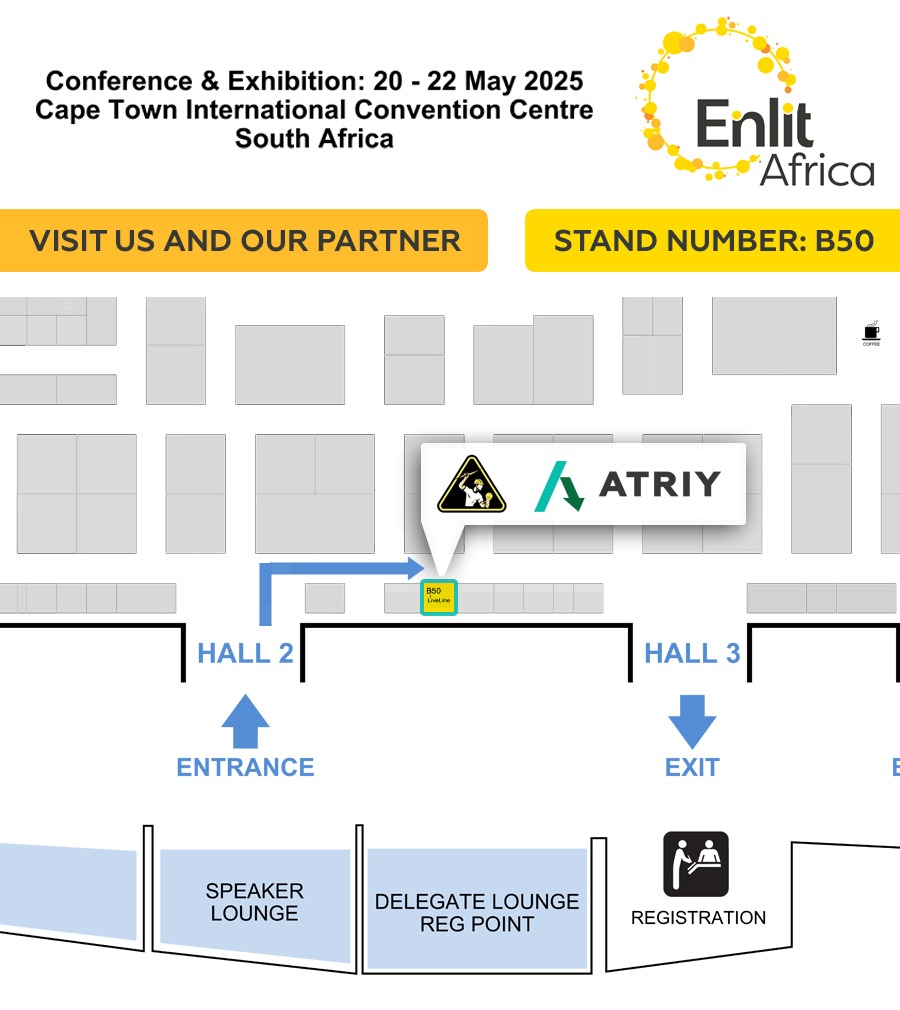
Morocco is interested in ATRIY equipment
Moroccan National Federation of Electricity, Electronics and Renewable Energies FENELEC visited the production facilities of ATRIY. It is the largest specialized association in Morocco, uniting 690 companies that represent 95% of the electrical engineering and electrical equipment market in the country. During the inspection, the members of the FENELEC association appreciated the company's high technology and full production cycle, especially the installation of chip components on a modern automatic line and quality standards. ATRIY specialists presented the manufactured equipment as well as new developments.
Following the visit, the parties confirmed their readiness for close cooperation in the use of ATRIY equipment at Moroccan energy facilities.






